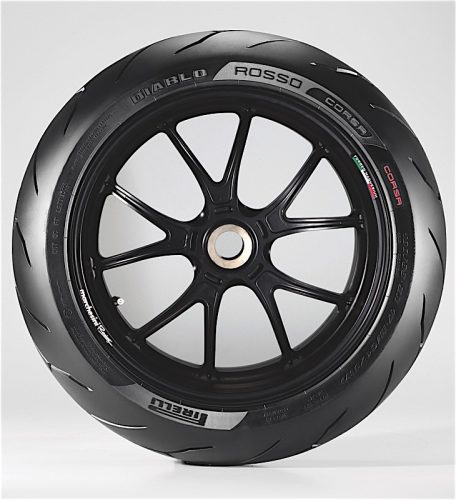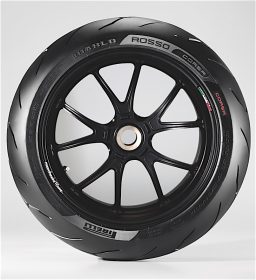Maybe the attention you pay to your tires doesn’t go beyond sprucing up the sidewalls with tire-cleaning products, but the next time you do that, have a closer look at them. Significant information is embossed into the sidewalls, much more than just the size and brand. This issue, we’ll look at various tire-size definitions and other important markings.
Although it has not been standardized, most motorcycle and tire makers use the metric sizing system, which looks like this: 100/90-19. Broken down, it means that 100 millimetres is roughly the width of the tire at its widest point. I say roughly, because the actual measurement varies between tire model and between brands, by as much as 10 mm.
The second number is the aspect ratio, or the height of the tire’s cross section, from the bead to the top of the tread, at the centre. In the example given, the tire is 90 percent as tall as it is wide, or about 90 mm from the bead to the top of the tread. The bead is the inner edge of the tire that mates with the wheel rim. The last number is the tire diameter, in inches, and in this case the tire would be mounted on a 19-inch wheel.
 Sometimes, especially with an older bike, you can use an equivalent, non-original tire size by calculating width versus height, if the original tire size is no longer available. Regardless of the type of motorcycle, don’t deviate from the standard tire dimensions, as this will affect handling, and not necessarily in a good way.
Sometimes, especially with an older bike, you can use an equivalent, non-original tire size by calculating width versus height, if the original tire size is no longer available. Regardless of the type of motorcycle, don’t deviate from the standard tire dimensions, as this will affect handling, and not necessarily in a good way.
Another sizing system, once standard on older motorcycles but now rarely used, is the standard inch system, which looks like this: 3.50H19. This size only provides the width of the tire, in inches, which in this case would be about 3-1/2 inches. The aspect ratio of standard inch-type tires is usually about 100 percent, so its cross section would be about as tall, and made to fit a 19-inch wheel. An equivalent metric replacement tire for this size would be a 90/90H19. The H in the size is the speed index, but more on that later.
There’s also a low-profile inch system. This looks very similar to the standard inch system, except that the aspect ratio is either 82 (default) or 85 percent. A tire measuring 4.25H18 measures 4-1/4 inches wide and would have an aspect ratio of 82 percent (default, unspecified in the size), or a cross section 3.485 inches tall. If the tire were marked 4.25/85H18, it would have an aspect ratio of 85 percent, or a cross section 3.6125 inches tall. You can still find tires in both inch sizing systems, though they are usually vintage reproduction tires or odd, off-road tires.
The final sizing system is alphanumeric, which looks like this: MT90H16. In this system the first letter, always an M, indicates the tire is manufactured for motorcycle use. The second letter is the tire width. The most common alphanumeric widths are MH, MJ, ML, MT and MU, which translate to 3, 3.25, 3.5, 5 and 5.5 inches wide. The first number in the alphanumeric system is the aspect ratio, and the second number is the diameter. Some Harleys still come equipped with alphanumeric tires.
Another important tire identifier, usually incorporated into the size markings, is the speed index. The speed index is the maximum speed that the tire can be used at, while carrying the maximum load according to its load rating. The most commonly used speed ratings are S (180 km/h), H (210 km/h), V (240 km/h) and Z (more than 240 km/h).
The speed index is often combined with the load index, usually located after the tire size and looking like this: 62H. In this example, the tire can withstand a load of 265 kg (584 lb.), and has an H speed index. The motorcycle tire load index ranges from 51 (195 kg) to 68 (315 kg).
Less conspicuous are the tread-wear indicators, located at several points on the sidewall, right at the edge of the tread. These are identified by the letters TWI, and usually have a small arrow pointing toward the tread. The TWI is a raised band of rubber running radially across the tread, usually measuring about 2/32 inch, which becomes visible when the tire tread has worn to its minimum height. When the TWI is exposed at the centre of the tread, it means it’s time to replace the tire.
Another important marking to look for, especially when buying off-road tires for an adventure-touring bike, identifies whether it’s a tube-type or tubeless tire. You’ll either see TT or Tube Type for a tire requiring an inner tube, or TL or Tubeless on a tubeless tire. This is very important, because although you can install an inner tube in a tubeless tire, you cannot run a tube-type tire in a tubeless configuration. You can mount a tube-type tire on a tubeless rim, but the bead won’t mate properly with the rim, and it will leak without a tube.
All street-legal motorcycle tires have a DOT serial number, beginning with the letters DOT and ending with a four-digit date code. The first two digits of the date code indicate the week of manufacture, and the last two indicate the year. Therefore, if the date code is 2512, the tire was manufactured on the 25th week of 2012. This is useful when buying closeout-sale or garage-sale tires; if it’s a three-digit code, leave the tire where it sits – it was manufactured before 2000.
Technical articles are written purely as reference only and your motorcycle may require different procedures. You should be mechanically inclined to carry out your own maintenance and we recommend you contact your mechanic prior to performing any type of work on your bike.











